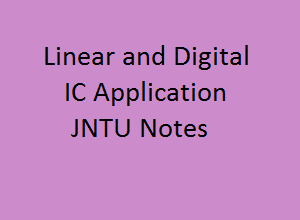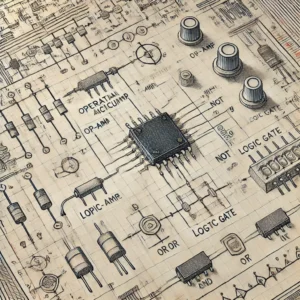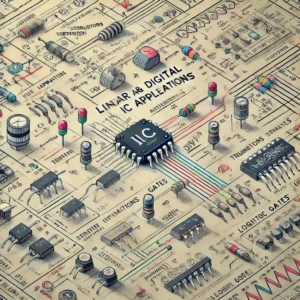Here you can download the free lecture Notes of Linear and Digital IC Applications Notes Pdf – ICA Notes Pdf materials with multiple file links to download. Linear and Digital IC Applications Pdf Notes – ICA Pdf Notes book starts with the topics.
The Linear and Digital IC Applications Notes Pdf – ICA Notes Pdf
Linear and Digital IC Application Notes pdf – ICA pdf notes – ICA notes pdf file to download are listed below please check it –
Linear and Digital IC Applications Notes Book
Latest Material Links
Unit 1
Link – Complete Notes
Unit 2
Link – Unit 1 Notes
Unit 3
Link – Unit 2 Notes
Unit 4
Link – Unit 3 Notes
Unit 5
Link – Unit 4 Notes
Unit 6
Link – Unit 5 Notes
Old Material Links
Unit 1
Link: Complete Notes
Unit 2
Link: Unit 1 Notes
Unit 3
Link: Unit 2 Notes
Unit 4
Link: Unit 3 Notes
Unit 5
Link: Unit 4 Notes
Unit 6
Link: Unit 5 Notes
Unit 7
Link: Unit 6 Notes
Unit 8
Link: Unit 7 Notes
Unit 9
Link: Unit 8 Notes
Note :- These notes are according to the R09 Syllabus book of JNTU.In R13 and R15,8-units of R09 syllabus are combined into 5-units in R13 and R15 syllabus. If you have any doubts please refer to the JNTU Syllabus Book.
Linear and Digital IC Applications Notes PDF – ICA Notes PDF Lecture Notes for B. Tech (2025) – JNTUH
Linear and Digital IC Applications (ICA) Notes PDF are an invaluable resource for B.Tech students, particularly those studying under the JNTUH curriculum. This subject covers both linear and digital integrated circuits, providing a comprehensive understanding of their applications, functionalities, and underlying principles. For students looking to master this subject, having access to well-organized and detailed notes is essential. Below, we will explore the content of these notes, focusing on what each unit covers, why these topics are important, and how students can best utilize this material for their academic success.
Linear and Digital IC Applications Notes, PDF | ICA B.Tech (2025) JNTUH
Description: The Linear and Digital IC Applications notes (ICA Notes PDF) are crucial for B.Tech students at JNTUH. These notes offer a structured approach to learning the intricate details of integrated circuits, both linear and digital. The content is aligned with the JNTUH syllabus, making it an essential tool for students preparing for exams and assignments.
Integrated circuits (ICs) are the backbone of modern electronic devices. Whether you’re dealing with simple gadgets or complex systems, understanding how ICs work and how to apply them is fundamental. This subject dives into the operational aspects of ICs, covering a wide array of topics from operational amplifiers (Op-Amps) to digital logic circuits, phase-locked loops, and data converters.
Linear and Digital IC Applications Notes | PDF, Syllabus, Books | B.Tech (2025)
Overview: The ICA Notes PDF provides a detailed overview of both linear and digital integrated circuits, offering insights into their design, functionality, and practical applications. The notes are divided into several units, each focusing on specific aspects of ICs, ensuring that students gain a thorough understanding of the subject.
Linear and digital ICs are categorized based on their functionality and the type of signal they handle. Linear ICs, such as operational amplifiers, are used to amplify signals and are essential in analog signal processing. Digital ICs, on the other hand, handle digital signals and are used in logic gates, counters, and other digital applications. Understanding both types is critical for any electronics or electrical engineering student.
The following topics are covered in Linear and Digital IC Applications handwritten Notes:
Unit 1: Integrated Circuits (ICs)
- Classification of ICs: This section introduces the various types of ICs, including analog, digital, and mixed-signal ICs. Understanding the classification helps students to identify the appropriate ICs for different applications.
- Chip Size and Circuit Complexity: Discusses the physical aspects of ICs, including the relationship between chip size, circuit complexity, and performance.
- Basic Information on Op-Amps: Operational amplifiers are a key component in linear ICs. This section covers the basic theory behind Op-Amps, including their internal circuits and ideal vs. practical characteristics.
- DC and AC Characteristics of Op-Amps: This topic explains how Op-Amps behave under different conditions, focusing on their DC and AC performance parameters.
- 741 Op-Amp Features: The 741 Op-Amp is a widely used IC, and this section delves into its features, specifications, and various modes of operation, including inverting, non-inverting, and differential modes.
Unit 2: Op-Amp Applications
- Basic Applications of Op-Amps: This unit explores the fundamental applications of operational amplifiers, such as amplifiers, voltage followers, and active filters.
- Instrumentation Amplifier: A crucial application of Op-Amps in precise measurement systems, where the amplifier’s ability to amplify small differential signals while rejecting large common-mode signals is essential.
- AC Amplifier: Focuses on the design and application of AC amplifiers using Op-Amps, which are used in audio and communication systems.
- V to I and I to V Converters: These converters are vital in interfacing analog signals with digital systems. This section explains how Op-Amps are used to perform these conversions.
- Sample & Hold Circuits: These circuits are essential in digital-to-analog conversion processes, where they hold the sampled value of a signal for a certain period.
- Multipliers and Dividers: The implementation of analog multiplication and division using Op-Amps is discussed here, which is crucial in applications like modulators and demodulators.
- Differentiators and Integrators: These circuits are used in signal processing to perform mathematical operations on signals. The design and application of these circuits are explored in detail.
- Comparators and Schmitt Triggers: Op-Amps are also used as comparators in various applications. Schmitt triggers, which are special types of comparators, are also discussed.
- Multivibrators: The role of Op-Amps in generating different types of waveforms (e.g., square waves) is covered here.
- Introduction to Voltage Regulators: This section introduces voltage regulators, focusing on the popular 723 voltage regulator IC.
Unit 3: Active Filters and Oscillators
- Introduction to Filters: Filters are used to select or reject specific frequency components from a signal. This section introduces various types of filters, including low-pass, high-pass, band-pass, and band-reject filters.
- 1st Order LPF and HPF Filters: These are basic filter designs that are used in a variety of applications. The theory behind their design and implementation is discussed.
- Band Pass, Band Reject, and All Pass Filters: These filters are more complex and are used in specific signal processing applications. Their design and practical applications are explored.
- Oscillator Types and Principles of Operation: Oscillators are essential in generating periodic signals. This section covers the different types of oscillators, including RC, Wien bridge, and quadrature oscillators.
- Waveform Generators: The design of waveform generators, such as triangular, sawtooth, and square wave generators, is discussed in detail.
- Voltage-Controlled Oscillators (VCOs): VCOs are used in a variety of applications, including phase-locked loops and frequency synthesis. This section covers their design and operation.
Unit 4: Timers and Phase-Locked Loops
- Introduction to 555 Timer: The 555 timer is one of the most popular ICs used in timing applications. This section covers its functional diagram, operation modes (monostable and astable), and various applications.
- Schmitt Trigger: The role of Schmitt triggers in creating stable output signals in noisy environments is explored.
- Phase-Locked Loop (PLL): PLLs are used in a variety of applications, including frequency synthesis, modulation, and demodulation. This section covers the block diagram, principle of operation, and individual blocks of the 565 PLL IC.
Unit 5: Digital-to-Analog (DAC) and Analog-to-Digital Converters (ADC)
- Introduction to DAC and ADC: Converters are essential in bridging the analog and digital worlds. This section introduces the basic principles of DACs and ADCs.
- Basic DAC Techniques: Various techniques used in DACs, such as weighted resistor DAC and R-2R ladder DAC, are discussed.
- Inverted R-2R DAC and IC 1408 DAC: These specific DAC implementations are covered in detail, explaining their design and application.
- Different Types of ADCs: This section covers the major types of ADCs, including parallel comparator type, counter type, successive approximation type, and dual slope ADC.
- DAC and ADC Specifications: The key specifications that define the performance of DACs and ADCs are discussed here, including resolution, accuracy, and speed.
Unit 6: Classification and Comparison of Integrated Circuits
- Classification of Integrated Circuits: This unit revisits the classification of ICs, focusing on their operational domains and complexity levels.
- Comparison of Various Logic Families: Logic families are fundamental to digital circuit design. This section compares different logic families, such as TTL, CMOS, and ECL, in terms of speed, power consumption, and compatibility.
- Standard TTL NAND Gate – Analysis & Characteristics: The TTL NAND gate is one of the building blocks of digital circuits. This section covers its design, characteristics, and analysis.
- TTL Open Collector Outputs and Tristate Outputs: The operation of TTL gates with open collector outputs and their applications in wired-AND logic are discussed.
- MOS & CMOS Open Drain and Tristate Outputs: This section covers the design and application of MOS and CMOS gates with open drain outputs, focusing on their role in digital circuit design.
- CMOS Transmission Gate: The CMOS transmission gate is a versatile component used in analog switches and multiplexers. This section explains its operation and applications.
- IC Interfacing: The challenges and solutions in interfacing TTL and CMOS circuits are discussed here, focusing on driving considerations and signal compatibility.
Unit 7: Design Using TTL-74XX & CMOS 40XX Series
- Code Converters, Decoders, and Demultiplexers: This section covers the design of code converters, decoders, and demultiplexers using TTL and CMOS ICs, which are essential components in digital systems.
- Encoders and Priority Encoders: Encoders are used to convert information from one format to another, and priority encoders are used in situations where multiple inputs need to be prioritized.
- Multiplexers and Their Applications: Multiplexers are used to select one of several input signals and forward it to a single output line. This section covers their design and application.
- Priority Generators/Checker Circuits: These circuits are used in complex digital systems to generate or check priorities among signals.
- Arithmetic Circuits: This section covers the design of parallel binary adder/subtractor circuits using the 2’s complement system, which is fundamental in arithmetic operations within digital systems.
- Magnetic Comparator Circuits: These circuits are used in various applications to compare digital signals and determine the magnitude relationship between them.
Unit 8: Sequential Circuits
- Commonly Available 74XX & CMOS 40XX Series of ICs: This section provides an overview of the commonly used IC series in digital circuit design, focusing on the 74XX and CMOS 40XX series.
- Flip-Flops (RS, JK, Master-Slave, D, and T Types) & Their Conversions: Flip-flops are the building blocks of sequential circuits. This section covers the design, operation, and conversion of different types of flip-flops.
- Synchronous and Asynchronous Counters: Counters are used in various applications, such as timing, frequency division, and event counting. This section covers the design and operation of both synchronous and asynchronous counters.
- Decade Counter: The decade counter is a specific type of counter that counts from 0 to 9. Its design and application are discussed here.
- Shift Registers & Applications: Shift registers are used to store and shift data within digital systems. This section covers their design, operation, and practical applications.
Reference:
- Operational Amplifiers and Linear Integrated Circuits – R.F. Coughlin and Fredrick F. Driscoll, PHI, 1977.
- Operational Amplifiers and Linear Integrated Circuits: Theory and Applications – Denton J. Daibey, TMH.
- Design with Operational Amplifiers and Analog Integrated Circuits – Sergio Franco, McGraw Hill, 3rd Ed., 2002.
Textbooks:
- Linear Integrated Circuits – D. Roy Chowdhury, New Age International (P) Ltd, 2nd Ed., 2003.
- Op-Amps & Linear ICs – Ramakanth A. Gayakwad, PHI, 1987.
- Digital Fundamentals – Floyd and Jain, Pearson Education, 8th Edition, 2005.
ICA Notes PDF from JNTUH
These notes are meticulously crafted for students of JNTUH and are aligned with the university’s syllabus, making them indispensable for exam preparation. The notes are comprehensive and easy to understand, ensuring that students grasp even the most complex concepts with ease.
Always Choose Smartzworld to Download ICA Notes PDF
Smartzworld is your go-to source for downloading the latest and most accurate Linear and Digital IC Applications Notes PDF. With its user-friendly interface and organized content, Smartzworld makes it easy for students to access the study material they need to excel in their exams.
Benefits of FREE ICA Handwritten Notes PDF:
- Comprehensive Coverage: These notes cover all the units and topics in the JNTUH syllabus, ensuring that students have access to all the information they need.
- Easy to Download: The notes are available for download through direct links, making it convenient for students to access them.
- Up-to-Date Material: The notes are regularly updated to reflect the latest syllabus and exam patterns, ensuring that students are always prepared.
- Free Access: All the notes are available for free, making high-quality study material accessible to all students.
FAQs
Q1. Where can I download the Linear and Digital IC Applications Notes PDF?
You can download the notes from the provided links for each unit or the complete set from Smartzworld.
Q2. How to download the ICA Notes PDF?
Click on the provided links to access and download the notes.
Q3. How many modules are covered in the ICA Notes PDF?
The ICA Notes PDF covers eight modules, corresponding to the eight units in the syllabus.
Q4. Topics Covered in ICA Notes PDF?
The notes cover integrated circuits, operational amplifiers, active filters, oscillators, timers, DAC/ADC, digital logic families, and sequential circuits.
Q5. Where can I get the complete ICA Handwritten Notes PDF FREE Download?
You can download the complete handwritten notes PDF for free from Smartzworld.
Q6. How to download ICA Handwritten Notes PDF?
Visit the provided links on Smartzworld, and you can easily download the handwritten notes.
Q7. How to Download FREE ICA Notes PDF?
Simply click on the download links provided for each unit on Smartzworld to access the free PDF notes.



